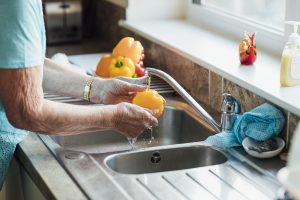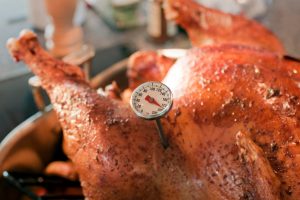When preparing food, remember to use the Core Four to prevent the risk of food poisoning in your home.
- Wash your hands frequently with soap and warm water, especially before handling food or eating, after handling raw meats, using the toilet, touching pets/animals, and changing diapers.
- Wash counters, utensils, cutting boards, and other surfaces with hot soapy water after they come into contact with raw meat.
- Wash all produce thoroughly with water before cooking or eating.
- Don’t cross-contaminate! Separate raw meat, poultry, seafood and eggs from other foods in your grocery shopping cart, grocery bags, and in your refrigerator.
- Store raw meats below ready-to-eat foods, on lower refrigerator shelves, to prevent contamination caused by dripping.
- Use one cutting board for fresh produce and a separate one for raw meat, poultry and seafood.
- Never place cooked food on a plate that previously held raw meat, poultry, seafood, or eggs.
- Cook food thoroughly to kill harmful bacteria that may be present in or on the food. This is very important for poultry and ground beef.
- Use a kitchen (or food) thermometer to make sure that the food is cooked to a safe internal temperature.
- Keep all hot foods at 60˚C (140˚F) or more, to prevent the growth of bacteria.
- Follow the table below to ensure you cook food to the proper temperature.
| Food | Temperature Needed |
| Mixtures containing poultry, eggs, meat, fish etc. | Internal Temperature of 74˚C (165˚F) for 10 minutes |
| Pork, Lamb, Veal, Beef (whole cuts) | Internal Temperature of 70˚C (158˚F) |
| Roast Beef (rare) | Internal Temperature of 63˚C (145˚F) for 3 minutes |
| Poultry | Internal Temperature of 85˚C (185˚F) for 15 seconds |
| Stuffing in Poultry | 74˚C (165˚F) |
| Ground Meat, Fish | 70˚C (158˚F) |
| Eggs | 63˚C (145˚F) for 15 seconds |
- Promptly refrigerate leftovers in uncovered, shallow containers to cool quickly.
- Refrigerate all perishable foods at 4˚C (40˚F) or less, to prevent the growth of bacteria.
- Thaw frozen foods in a refrigerator, cold water, or a microwave oven, not at room temperature.
- Do not refreeze thawed food.
For more information on food safety, visit Health Canada


